
The palm cockatoo, also known as the goliath cockatoo or great black cockatoo, is a large smoky-grey or black parrot of the cockatoo family native to New Guinea, Aru Islands, and Cape York Peninsula. It has a very large black beak and prominent red cheek patches.

Spix's macaw, also known as the little blue macaw, is a macaw native to Brazil. It is a member of Tribe Arini in the subfamily Arinae, part of the family Psittacidae. It was first described by German naturalist Georg Marcgrave, when he was working in the State of Pernambuco, Brazil, in 1638 and it is named for German naturalist Johann Baptist von Spix, who collected a specimen in 1819 on the bank of the Rio São Francisco in northeast Bahia in Brazil.

Anodorhynchus is a genus of large blue macaws from open and semi-open habitats in central and eastern South America. It includes two extant species, the hyacinth macaw and Lear's macaw also known as the indigo macaw, and one probably extinct species, the glaucous macaw. At about 100 centimetres (39 in) in length the hyacinth macaw is the longest parrot in the world. Glaucous and Lear's macaws are exclusively cliff nesters; hyacinth macaws are mostly tree nesters. The three species mainly feed on the nuts from a few species of palms.

The glaucous macaw is a large, all-blue South American parrot, a member of a large group of neotropical parrots known as macaws. This macaw, generally believed to be extinct, is closely related to Lear's macaw A. leari and the hyacinth macaw A. hyacinthinus. In Guaraní, it is called guaa-obi after its vocalizations.
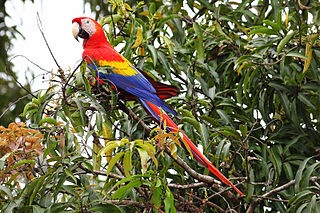
The scarlet macaw is a large red, yellow, and blue Central and South American parrot, a member of a large group of Neotropical parrots called macaws. It is native to humid evergreen forests of tropical Central and South America. Range extends from south-eastern Mexico to the Peruvian Amazon, Colombia, Bolivia, Venezuela and Brazil in lowlands of 500 m (1,640 ft) up to 1,000 m (3,281 ft). It has suffered from local extinction through habitat destruction and capture for the parrot trade, but in other areas it remains fairly common. Formerly it ranged north to southern Tamaulipas. It can still be found on the island of Coiba. It is the national bird of Honduras. Like its relative the blue and gold macaw, scarlet macaws are popular birds in aviculture as a result of their striking plumage.
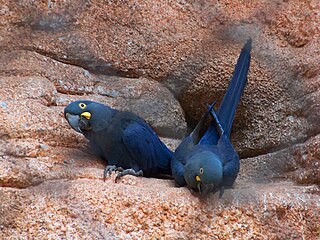
Lear's macaw, also known as the indigo macaw, is a large all-blue Brazilian parrot, a member of a large group of neotropical parrots known as macaws. It was first described by Charles Lucien Bonaparte in 1856. Lear's macaw is 70–75 cm (28–30 in) long and weighs around 950 g (2.09 lb). It is metallic blue with a faint, often barely visible, tinge of green, and a yellow patch of skin at the base of the heavy, black bill.
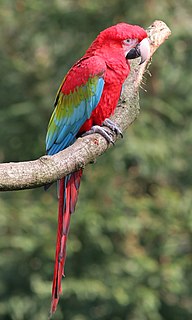
The red-and-green macaw, also known as the green-winged macaw, is a large, mostly-red macaw of the genus Ara.

The blue-and-yellow macaw, also known as the blue-and-gold macaw, is a large South American parrot with mostly blue top parts and light orange underparts, with gradient hues of green on top of its head. It is a member of the large group of neotropical parrots known as macaws. It inhabits forest, woodland and savannah of tropical South America. They are popular in aviculture because of their striking color, ability to talk, ready availability in the marketplace, and close bonding to humans.
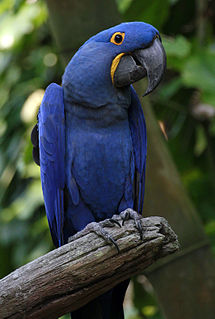
The hyacinth macaw, or hyacinthine macaw, or more commonly called the “Blue macaw” is a parrot native to central and eastern South America. With a length of about 100 cm (3.3 ft) it is longer than any other species of parrot. It is the largest macaw and the largest flying parrot species, though the flightless kakapo of New Zealand can outweigh it at up to 3.5 kg. While generally easily recognized, it could be confused with the smaller Lear's macaw. Habitat loss and the trapping of wild birds for the pet trade have taken a heavy toll on their population in the wild, so the species is classified as Vulnerable on the International Union for Conservation of Nature's Red List, and it is protected by its listing on Appendix I of the Convention on International Trade in Endangered Species of Wild Fauna and Flora (CITES).

The blue-throated macaw, also known as the Caninde macaw or Wagler's macaw, is a macaw endemic to a small area of north-central Bolivia, known as Los Llanos de Moxos. In 2014 this species was designated by law as a natural patrimony of Bolivia, where it is known as barba azul, which means 'blue beard' in Spanish. Recent population and range estimates suggests that about 350–400 individuals remain in the wild. The main causes of their demise is capture for the pet trade. It is currently considered critically endangered and the parrot is protected by trading prohibitions.

The red-bellied macaw, also known as Guacamaya Manilata, is a medium-sized, mostly green South American parrot, a member of a group of large Neotropical parrots known as macaws. It is the largest of what are commonly called "mini-macaws". The belly has a large maroon patch which gives the species its name.

Mauritia flexuosa, known as the moriche palm, ité palm, ita, buriti, muriti, canangucho (Colombia), or aguaje (Peru), is a palm tree. It grows in and near swamps and other wet areas in tropical South America. It has been reported from Trinidad, Colombia, Venezuela, Guyana, Suriname, French Guiana, Brazil, Ecuador, Peru, and Bolivia.

The great green macaw, also known as Buffon's macaw or the great military macaw, is a Central and South American parrot found in Nicaragua, Honduras, Costa Rica, Panama, Colombia and Ecuador. This species lives in the canopy of wet tropical forests and is highly dependent on the almendro tree . Two allopatric subspecies are recognized; the nominate subspecies occurs from Honduras to West Colombia, while Ara ambiguus guayaquilensis is isolated on the Pacific side of the continent in Ecuador, and possibly South-Western Colombia.

The Cuban macaw or Cuban red macaw was a species of macaw native to the main island of Cuba and the nearby Isla de la Juventud that became extinct in the late 19th century. Its relationship with other macaws in its genus was long uncertain, but it was thought to have been closely related to the scarlet macaw, which has some similarities in appearance. It may also have been closely related, or identical, to the hypothetical Jamaican red macaw. A 2018 DNA study found that it was the sister species of two red and two green species of extant macaws.

The blue-headed macaw or Coulon's macaw is native to eastern Peru, north-western Bolivia, and far western Brazil. It has a total length of about 41 cm (16 in), making it a member of the group of smaller macaws sometimes known as the mini-macaws, which includes any species of macaw with a total length of 50 cm (20 in) or less. As in all macaws, its tail is long and pointed and the bill is large and heavy.
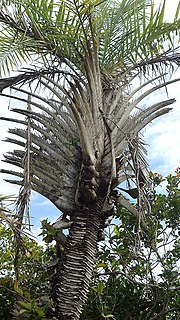
Syagrus coronata, the Ouricury palm or licuri palm, is a species of palm tree that plays an important role in the diets of tropical seasonally dry forest animals. It is native to eastern Brazil, ranging from the southern part of the state of Pernambuco, into the state of Bahia, south to the Jequitinhonha River in the state of Minas Gerais.

The Lesser Antillean macaw or Guadeloupe macaw is a hypothetical extinct species of macaw that is thought to have been endemic to the Lesser Antillean island region of Guadeloupe. In spite of the absence of conserved specimens, many details about the Lesser Antillean macaw are known from several contemporary accounts, and the bird is the subject of some illustrations. Austin Hobart Clark described the species on the basis of these accounts in 1905. Due to the lack of physical remains, and the possibility that sightings were of macaws from the South American mainland, doubts have been raised about the existence of this species. A phalanx bone from the island of Marie-Galante confirmed the existence of a similar-sized macaw inhabiting the region prior to the arrival of humans and was correlated with the Lesser Antillean macaw in 2015. Later that year, historical sources distinguishing between the red macaws of Guadeloupe and the scarlet macaw of the mainland were identified, further supporting its validity.

The Tambopata Macaw Project is a long term research project on the ecology and conservation of macaws and parrots in the lowlands of south-eastern Peru under the direction of Donald Brightsmith of the Schubot Exotic Bird Health Center at Texas A&M University. The project has been working with wildlife and local communities since 1989. The long term research and monitoring has provided many insights into various aspects of parrot and wildlife of south-eastern Peru. Macaws are among the most effective flagship species for ecosystem conservation in the Amazonian rainforest.


















